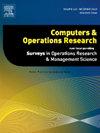基于突发卫生事件易感性指数的多模式疫苗配送网络选址问题建模
IF 4.3
2区 工程技术
Q2 COMPUTER SCIENCE, INTERDISCIPLINARY APPLICATIONS
引用次数: 0
摘要
传染性病毒爆发引起的卫生紧急情况增加了有效的疫苗分发战略以控制其传播的必要性。本文提出了两阶段策略来解决这一问题。第一阶段考虑疾病数据和合并症情况,构建各地区突发卫生事件易感指数。第二阶段使用HESI,并针对不同的应用场景提出三个版本的优先级权重。将这些作为优先级权重来制定具有多模式网络和多类型冰箱的容量定位问题。该模型考虑了其他因素,如存储容量、位置、运输距离(包括空中和地面选项)、成本(维护和运输)和车辆容量。为了求解大型网络的模型,本文提出了一种基于极端方向的Benders分解的求解方法。为了验证这些模型,我们研究了印度COVID-19疫苗分发的案例。为了评估易感性指数对设施位置的影响,建议的权重版本与未使用该指数的版本进行了比较。结果表明,基于人口易感比加权方案的三种方案中,有一种方案的分配策略最具成本效益,能够保证所有易感地区的覆盖。此外,基于分解的解决方案显着提高了计算效率,解决问题的速度比商用求解器快50倍以上。本文章由计算机程序翻译,如有差异,请以英文原文为准。
Modelling a capacitated location problem for designing multimodal vaccine distribution network using a novel Health Emergency Susceptibility Index
Health emergency due to the outbreak of a contagious virus augments the need for effective vaccine distribution strategies to control its spread. This paper suggests a two-phase strategy to solve this problem. Phase I constructs a Health Emergency Susceptibility Index for each region, considering the disease data and comorbidity situation. Phase II uses the HESI and proposes three versions of priority weights for different application scenarios. These are used as the priority weights to formulate a capacitated location problem with a multimodal network and multiple types of refrigerators. The model considers additional factors like storage capacity, locations, transportation distances (including air and ground options), costs (maintenance and transportation), and vehicle capacity. To solve the model for large networks, the paper suggests a solution approach using Benders Decomposition with extreme directions. To validate the models, we examine the case of COVID-19 vaccine distribution in India. To assess the impact of the Susceptibility Index on facility locations, proposed weightage versions are compared with a version that does not use the index. The results show that one of the three versions with weighting schemes based on the population-to-susceptibility ratio leads to the most cost-effective distribution strategy, ensuring coverage of all susceptible regions. Furthermore, the Decomposition-based solution significantly improves computational efficiency, solving the problem over fifty times faster than the commercial solver.
求助全文
通过发布文献求助,成功后即可免费获取论文全文。
去求助
来源期刊

Computers & Operations Research
工程技术-工程:工业
CiteScore
8.60
自引率
8.70%
发文量
292
审稿时长
8.5 months
期刊介绍:
Operations research and computers meet in a large number of scientific fields, many of which are of vital current concern to our troubled society. These include, among others, ecology, transportation, safety, reliability, urban planning, economics, inventory control, investment strategy and logistics (including reverse logistics). Computers & Operations Research provides an international forum for the application of computers and operations research techniques to problems in these and related fields.
 求助内容:
求助内容: 应助结果提醒方式:
应助结果提醒方式:


